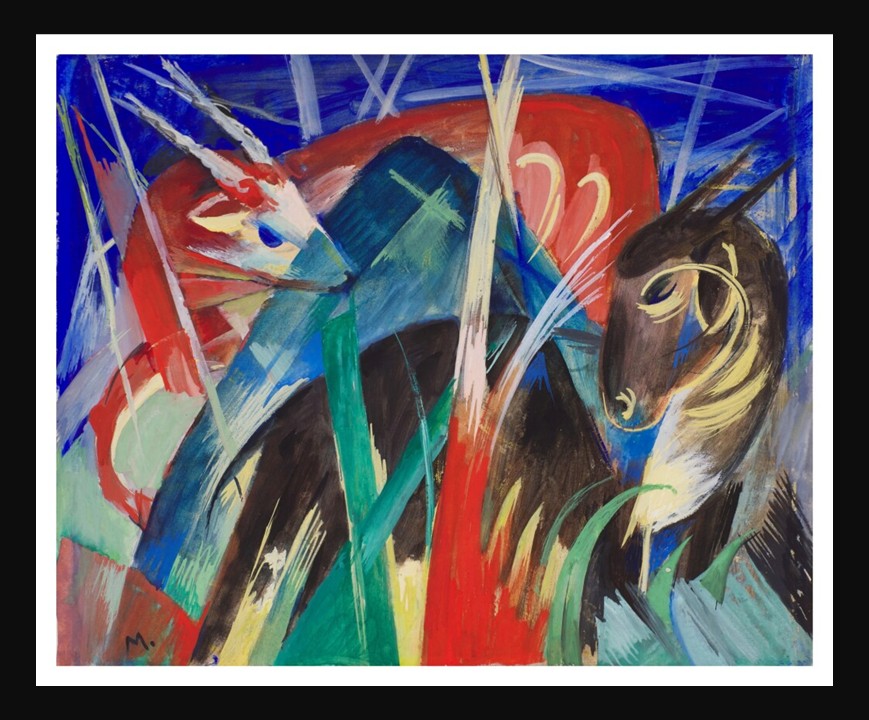
Fabulous Beasts I (Composition of Animals I), 1913, tempera and gouache on paper, 25.5×31.5 cm, Private Collection
https://www.sothebys.com/en/buy/auction/2021/modern-evening-auction/fabeltiere-i-tierkomposition-i-fabulous-beasts-i
Wassily Kandinsky’s recollection of Franz Marc offers a deeply revealing lens through which to approach Fabulous Beasts I (Composition of Animals I) (1913). Writing in 1936, Kandinsky described his younger colleague as an artist who ‘had a direct, intimate relationship with nature like a mountaineer or even an animal,’ drawn irresistibly to ‘everything in nature, but above all, the animals.’ This connection, Kandinsky explained, allowed Marc to ‘enter into the lives of animals.’ not as a mere observer but as a participant in their vitality. Yet Marc’s art, he emphasized, was never about literal depiction, ‘he never lost himself in details, never saw the animal as more than one of the elements of a whole.’ In Fabulous Beasts I, this vision is vividly realized… the animals merge into an interlocking harmony of color and form, expressing not their individuality but their shared pulse within the greater ‘organic whole’ of nature that, as Kandinsky observed, defined Marc’s singular artistic world.
Who was Franz Marc, the artist Kandinsky remembered with such admiration? Franz Marc was one of the central figures of German Expressionism and a founding member of Der Blaue Reiter, the avant-garde group he established with Kandinsky in 1911. Deeply spiritual and philosophical, Marc sought to reveal the unseen essence of the world rather than its surface appearance. He believed that animals, untouched by human corruption, embodied purity and harmony that modern life had lost. For Marc, painting them was not an act of observation but of communion, an attempt to visualize a higher spiritual order through form and color.
What drew him so powerfully to the world of animals? Marc viewed animals as symbols of innocence and unity with nature. In Fabulous Beasts I, the overlapping forms of horses, deer, and other creatures seem to dissolve into one another, reflecting this ideal of interconnectedness. Marc’s fascination was not with individual species but with the collective rhythm of life, the pulse that unites all beings. Through animals, he sought to express a vision of nature that was not separate from humanity but part of a divine totality.
How did his engagement with color and abstraction evolve in the years leading up to 1913? By 1913, Marc’s style had shifted from representational imagery toward a more abstract, spiritual expression. Influenced by Kandinsky’s theories of color and music, as well as by Cubism and Orphism, he began to use pure color as a vehicle of emotion and meaning. For the artist, blue symbolized the spiritual and male, yellow the joyful and feminine, and red the material and violent. In Fabulous Beasts I, these hues collide and intertwine, animating the composition with dynamic energy. The result is less a scene from nature than a symphonic vision, an attempt to depict life’s spiritual vibrations.
What does this composition reveal about Marc’s search for unity between humanity, nature, and the divine? Fabulous Beasts I can be seen as a culmination of Marc’s lifelong search for harmony. The animals, abstracted and luminous, are not separate entities but fragments of a universal design. The compositionparticipatesense of cosmic balance, where every form and color participates in a shared rhythm. Marc’s belief that art could restore the spiritual connection between humanity and nature finds one of its purest expressions here.
Can this work be seen as a premonition of the transformation, and destruction, soon to come with the First World War? Painted in 1913, just before the outbreak of war and Marc’s own death in 1916, Fabulous Beasts I carries a poignant sense of forewarning. The swirling forms and intense colors, once symbols of unity, also suggest a world on the brink of dissolution. In retrospect, the painting reads as both a celebration of life’s sacred energy and a lament for its fragility. Through his vision, Marc seemed to sense that the harmony he sought in nature was about to be shattered by human conflict.
In the light of Kandinsky’s words, Fabulous Beasts I stands as a testament to Franz Marc’s rare ability to see beyond appearances into the spiritual essence of life. His art invites us to look at the world not through human eyes, but through a consciousness attuned to the rhythms of nature. Though his life was cut short by war, Marc’s vision endures, radiant, searching, and profoundly humane. In his ‘direct, intimate relationship with nature,’ he created not mere images of animals, but a timeless meditation on the unity of all living things.
For an engaging Student Activity inspired by Franz Marc’s Fabulous Beasts I (Composition of Animals I), please, Check… HERE!
Bibliography: https://www.sothebys.com/en/buy/auction/2021/modern-evening-auction/fabeltiere-i-tierkomposition-i-fabulous-beasts-i